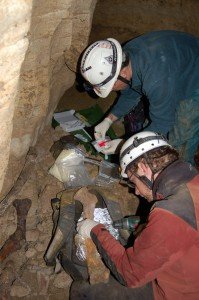Researchers have analysed DNA from bones of a number of giant extinct moa and used the data to make inferences about the size of the ancient moa population in New Zealand.

The research found that despite significant significant climate and environmental changes , the moa population size of the giant moa remained stable over the past 40,000 years until the first humans arrived in New Zealand around 1280 AD. Hunting of the moa by Polynesian settlers soon lead to the extinction of the giant bird, which could measure up to 2.5m in height.
The study was undertaken by researchers from the University of Waikato and Landcare Research in collaboration with US and Australian researchers. The results were published online this week the journal Quaternary Science Reviews.
Project leader Professor Alan Cooper (University of Adelaide) spoke to Radio New Zealand about the research this morning (listen to audio below):
The New Zealand Herald also covered the story. An excerpt:
Moa survived major climate changes – study
New Zealand’s now extinct giant moa survived for 40,000 years of significant climate and environmental changes without suffering large population slumps, new research shows.
An international team of scientists involving researchers from University of Waikato and Landcare Research has used ancient DNA from moa bones to conclude population numbers remained stable until the arrival of humans in New Zealand around 1280 AD.
The researchers say the study provides “overwhelming evidence” that the extinction of moa occurred due to overhunting and habitat destruction, at a time of relative climatic stability.
The giant birds – measuring up to 2.5m high and weighing 250kg – were the largest herbivores in New Zealand’s pre-human environment but were quickly exterminated after the arrival of Polynesian settlers.
Now, the new study, undertaken by researchers from the University of Adelaide’s Australian Centre for Ancient DNA, the University of Colorado, and the University of Waikato and Landcare Research, has revealed how the bird managed to adapt and overcome major environmental changes.
“Until now it has been difficult to determine how megafauna responded to environmental change over the past 50,000 years, because human arrival and climate change occurred simultaneously in many parts of the world,” says Dr Nic Rawlence, lead author of the study and a postdoctoral research fellow from the Australian Centre for Ancient DNA and the University of Waikato.